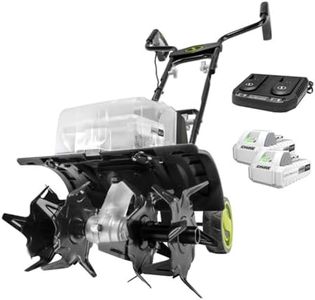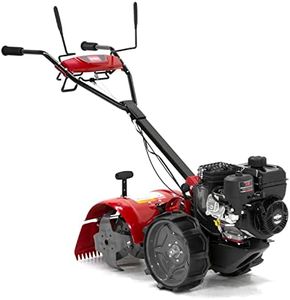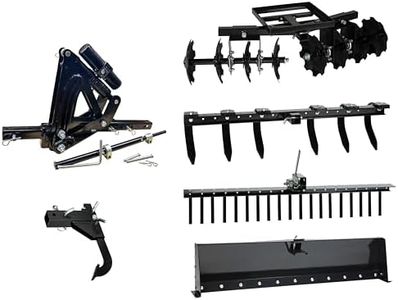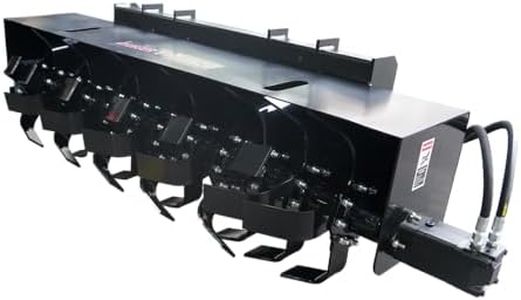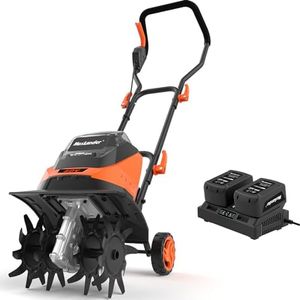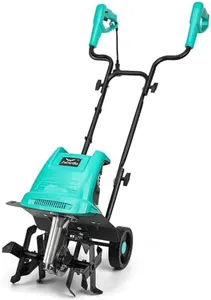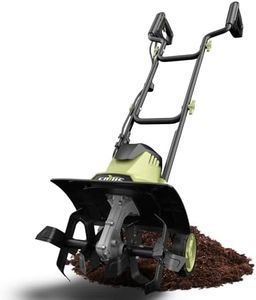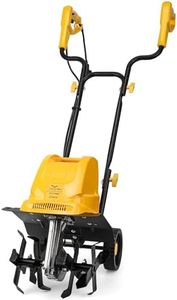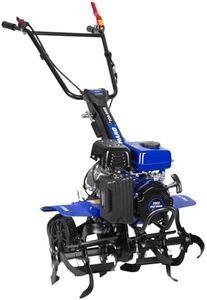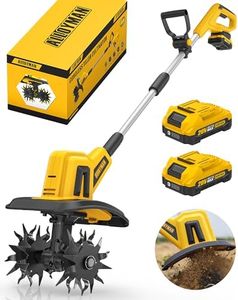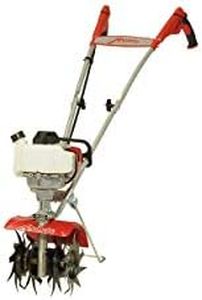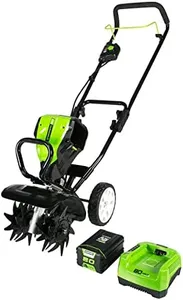10 Best Cultivators 2025 in the United States
Our technology thoroughly searches through the online shopping world, reviewing hundreds of sites. We then process and analyze this information, updating in real-time to bring you the latest top-rated products. This way, you always get the best and most current options available.

Our Top Picks
Winner
Toro Dual Direction Rear Tine Tiller, 127cc Briggs & Stratton 4-Cycle Engine, Airless Tires, Instant Reverse, Heavy Duty Stamped Steel Tines, Simple Shifting, Model: 58603
Most important from
58 reviews
The Toro Dual Direction Rear Tine Tiller is powered by a reliable 127cc Briggs & Stratton 4-cycle gas engine, providing enough power for medium-sized garden tasks. Its 17-inch tilling width and 10-inch maximum depth are good for preparing garden beds without being too large or heavy. Weighing 160 pounds, it’s on the heavier side, which adds stability during use but might be a bit challenging to move around for some. The dual-direction feature with instant reverse makes maneuvering easier, especially in tight spaces or when changing direction, which is a helpful design for less experienced users.
The tiller has heavy-duty stamped steel tines that include counter-rotating ones to break tough sod and standard rotating tines for creating a smooth seedbed, offering versatility in soil preparation. Airless tires add durability and eliminate the hassle of flat tires, a nice convenience for regular garden use. The handle design supports both one and two-handed operation, making it adaptable to different user preferences and tasks. The easy-shifting transmission simplifies control, though the size and weight mean it may not be ideal for very small or raised garden beds. Its gas fuel type delivers strong power but requires fuel handling and maintenance.
A 5-year limited warranty on the product and a 2-year warranty on the engine provide some peace of mind. This tiller is well suited for gardeners seeking a dependable, moderately powerful machine for breaking ground and preparing larger garden areas, though it may be less suitable for very compact spaces or those wanting a lightweight tool.
Most important from
58 reviews
IMPACT IMPLEMENTS® 6-Piece Hydraulic Implement Kit for ATV, UTV, and Garden Tractors - Includes Hydraulic Lift, Landscape Rake, Cultivator, Box Blade, Disc Plow, and Middle Buster.
The IMPACT IMPLEMENTS 6-Piece Hydraulic Implement Kit offers a versatile set of tools including a cultivator, landscape rake, box blade, disc plow, and more, designed to attach easily to ATVs, UTVs, and garden tractors. Its standout feature is the patented hydraulic system that enables efficient soil engagement and heavy lifting, which can make land preparation and maintenance simpler and less physically demanding. The one-pin mounting system allows quick switching between implements without tools, adding convenience for changing tasks.
Weighing 309 pounds, this kit is relatively heavy, so handling and transport require some effort and suitable equipment. Since it relies on the power source of your ATV or tractor, fuel type and engine specs depend on your existing machine. This kit is ideal for hobby farmers or landowners looking for a multipurpose solution to cultivate, grade, and clear land without buying separate tools.
While it does not specify details like engine power, tilling width or depth, number of tines, or handle design, it is best suited for users who already have a compatible vehicle to power and control these attachments. Customer support from the US-based team is a helpful bonus for setup and use questions.
EARTHQUAKE Victory Rear Tine Tiller, Powerful 209cc 4-Cycle Viper Engine, Rugged Bronze Gear Transmission, Counter-Rotating Tines, Instant Reverse, Pneumatic Wheels, Model: 39381, Red/Black
Most important from
317 reviews
The EARTHQUAKE Victory Rear Tine Tiller is equipped with a powerful 209cc Viper Engine that offers substantial power for breaking new ground and maintaining existing plots. The compact design aids in maneuverability, making it easier to navigate tight spaces and perform stable pivots. The tiller features counter-rotating tines that work in opposition to the self-propelled drive wheels, enhancing its efficiency in tilling tough soil.
Users can till up to 10 inches deep and 16 inches wide in a single pass, which is quite impressive for most gardening needs. The instant reverse function is a notable advantage, allowing users to change direction easily without needing to shift gears, which can be particularly useful at the end of garden rows or in confined areas. Additionally, the looped handlebars with three height adjustments offer ergonomic comfort during operation.
Built with a bronze gear drive transmission, heavy-duty forged tines, and an all-steel construction, this tiller is designed for durability. However, at 154 pounds, it is relatively heavy, which might make it a bit challenging to transport. Additionally, it is gas-powered, so users need to be comfortable with fueling and maintaining a gas engine. The EARTHQUAKE Victory Rear Tine Tiller is a robust and durable choice for gardeners needing a reliable and powerful tool, though its weight and gas-powered operation may not appeal to everyone.
Most important from
317 reviews
Buying Guide for the Best Cultivators
Choosing the right cultivator for your needs can make a significant difference in the efficiency and effectiveness of your gardening or farming tasks. Cultivators are essential tools for preparing soil, removing weeds, and mixing soil amendments. To make an informed decision, it's important to understand the key specifications and features that differentiate various models. By considering your specific needs and the characteristics of your land, you can select a cultivator that will best serve your purposes.FAQ
Most Popular Categories Right Now
